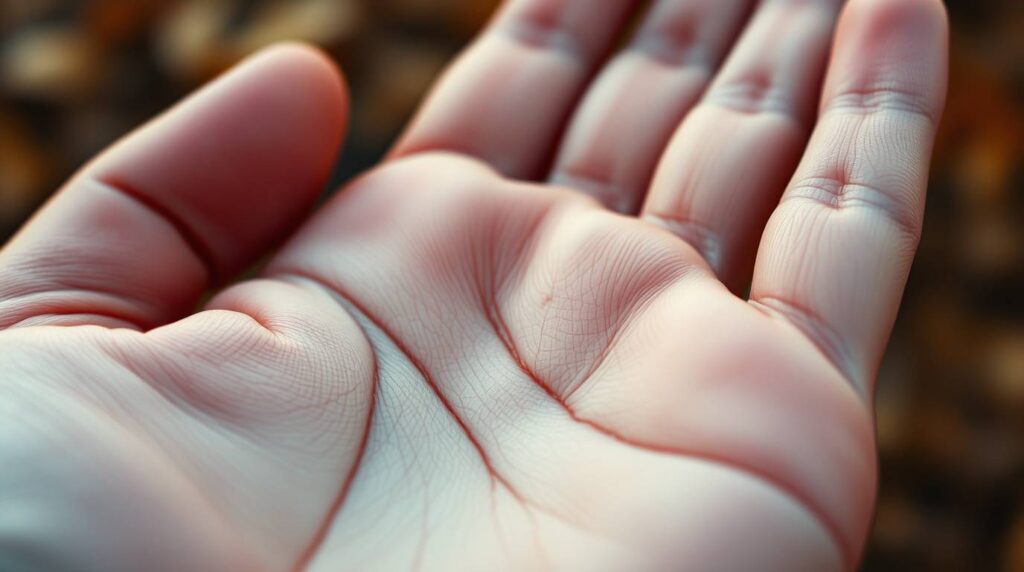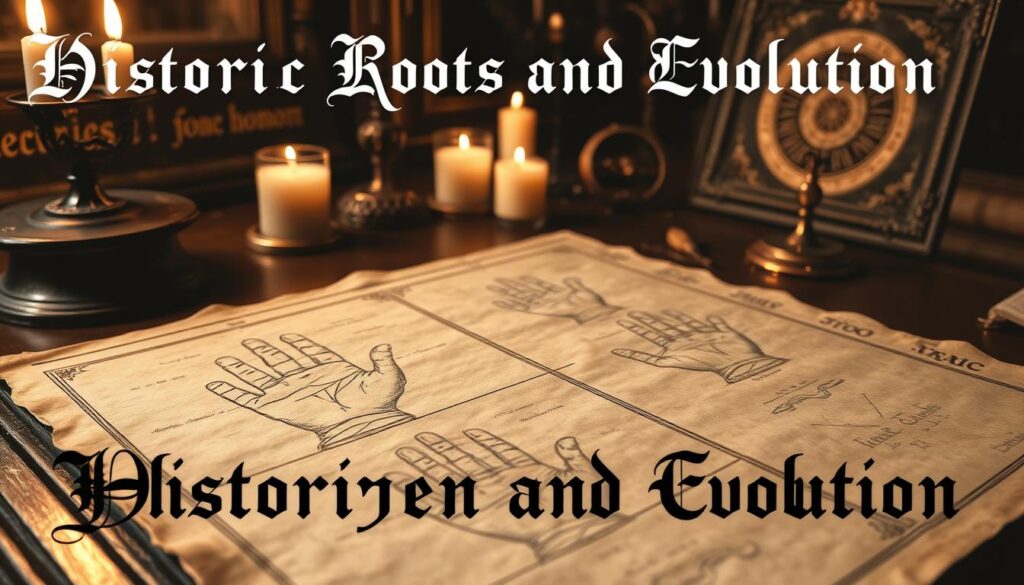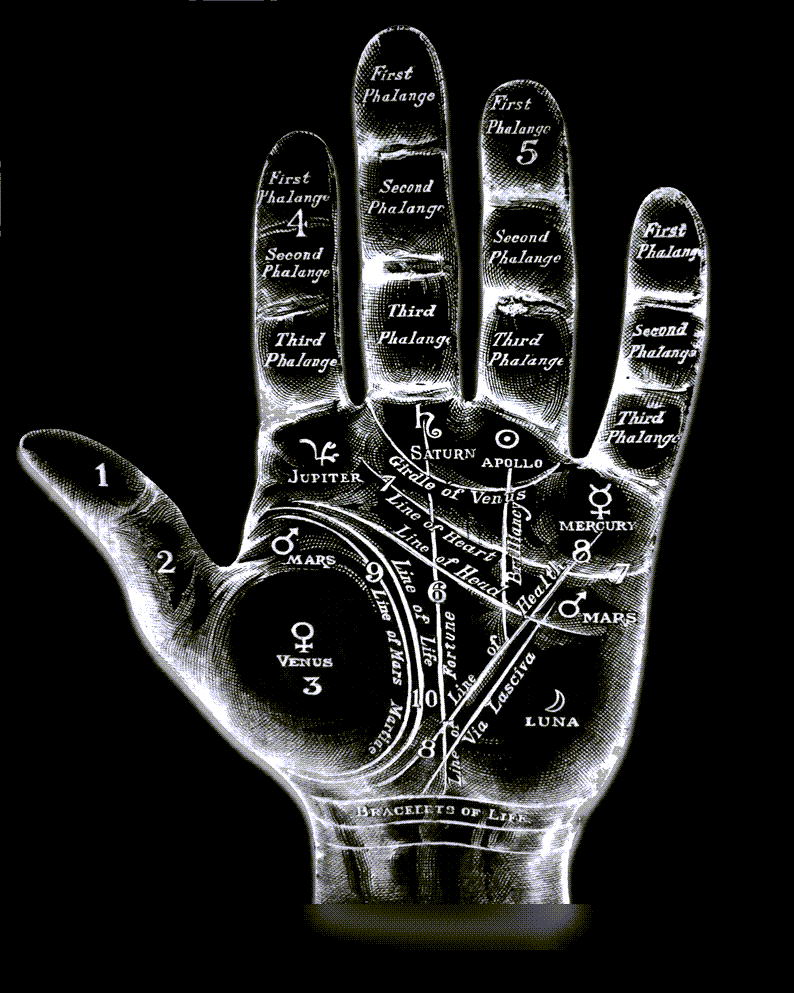Imagine sitting at a bustling street fair, watching a woman trace her finger along a stranger’s hand. “Your heart line shows deep empathy,” she says, pointing to a curve near the thumb. The crowd leans in, captivated. This moment – where curiosity meets self-discovery – is the essence of hand analysis, a practice as old as civilization itself.
For centuries, people have turned to their palms to decode personality traits and life patterns. Even Aristotle wrote about the significance of hand lines in ancient Greece. By the 19th century, this art evolved into a structured practice – one that blends intuition with careful observation of mounts, shapes, and creases.
Today, analyzing your hand isn’t just about fortune-telling. It’s a tool for understanding your strengths, challenges, and hidden potential. The length of your fingers, texture of your skin, and depth of your life line all form a map – one that reveals how your mind works and where your path might lead.
Key Takeaways
- Hand analysis interprets physical features to uncover personality and life patterns
- Rooted in ancient traditions, modernized during the Victorian era
- Examines lines, mounts, finger shapes, and skin texture
- Provides actionable insights for personal growth and decision-making
- Accessible to beginners through guided practice
Introduction to Palmistry
Your hands hold more than fingerprints – they carry a coded map of your emotional patterns and mental tendencies. This ancient practice examines three primary creases: the heart line (emotional nature), head line (thinking style), and life line (vitality levels). Together, they form a dynamic blueprint of how you process experiences.

What Shapes Your Story?
Each line’s depth and curvature reveal nuances. A deeply etched heart line suggests strong emotional awareness, while faint markings might indicate reserved tendencies. Breaks in the life line often correlate with major life shifts rather than lifespan predictions. The head line’s angle shows whether you lean toward practical decisions or creative problem-solving.
Why Dual-Hand Observation Matters
Your dominant hand reflects current life choices, while the non-dominant one shows innate potential. Comparing both helps identify growth areas. For example, a stronger head line on your writing hand might reveal developed logical skills that started as raw talent.
| Line | Key Insight | Visual Clues |
|---|---|---|
| Heart Line | Relationship patterns | Curves toward fingers = expressive nature |
| Head Line | Decision-making style | Straight = concrete thinker |
| Life Line | Energy management | Wide arc = adventurous spirit |
Modern practitioners combine these observations with psychological principles. They look for clusters of markings – like stars near the life line indicating unexpected opportunities. This approach transforms random creases into actionable self-knowledge.
Historical Roots and Evolution
Long before modern psychology, ancient cultures turned upward – not to stars, but to hands – seeking answers about human nature. This practice began in India over 3,000 years ago, where Hindu sages linked hand features to astrology and spiritual destiny. Valmiki, author of the epic Ramayana, reportedly wrote detailed texts about interpreting palms as life maps.

Origins in Ancient India and Beyond
The art traveled through Persia to Greece, where Aristotle analyzed hand lines in De Historia Animalium. Though his palmistry treatise vanished, his writings sparked interest across Europe. By medieval times, Romani travelers carried these techniques westward, adapting them to local beliefs.
Revival and Modern Integration
The 19th century transformed hand analysis. Occult societies like London’s Chirological Society blended ancient methods with new psychology. Captain Casimir D’Arpentigny classified hand shapes, while mystic Cheiro used readings to advise celebrities like Mark Twain. This revival made the practice accessible to everyday people.
Today’s approach mixes tradition with neuroscience. As one researcher notes:
“Your palm isn’t fate – it’s a mirror of habits etched through choices.”
Modern guides helppeopleuse these insights for career planning or relationship growth, proving this ancient art still speaks to the human experience.
Decoding Hand Shapes and Elements
Your hands reveal more than lines – their shape acts as a compass pointing to core personality traits. Practitioners categorize hands into four elemental types, each reflecting distinct behavioral patterns. These classifications help decode how individuals process information and engage with the world.

Understanding Earth, Air, Fire, and Water Hands
Earth hands feature square palms with sturdy, short fingers. People with this shape often excel in practical tasks and prefer tangible results. Think architects who transform blueprints into buildings or gardeners nurturing plants through seasonal changes.
Air hands stand out with rectangular palms and spindly fingers. Pronounced knuckles and lean fingers signal analytical thinkers – the kind who thrive in coding marathons or philosophical debates. These hands often belong to teachers explaining complex theories with clarity.
Those with fire hands display dynamic creases and shorter fingers paired with long palms. Their energy mirrors entrepreneurs pitching bold ideas or athletes pushing physical limits. Passion fuels their actions, whether launching startups or mastering new skills.
Water hands showcase narrow palms with long, tapered fingers. These sensitive shapes often belong to artists translating emotions into music or therapists intuiting unspoken struggles. Soft skin and flexible joints reinforce their creative, empathetic nature.
Finger length and texture refine these insights. Long fingers in air and water types suggest detail-oriented thinking, while shorter digits in fire hands reveal impulsive enthusiasm. By studying these traits, you gain tools for understanding strengths – and pathways for growth.
Exploring Major Palm Lines
What if your hands held keys to understanding your deepest motivations? The three primary creases reveal distinct aspects of your nature. While each line tells its own story, their combined patterns create a roadmap for self-awareness.
The Heart Line: Love and Relationships
The uppermost horizontal crease – your heart line – acts as an emotional barometer. A long, unbroken curve stretching toward the index finger signals idealistic romantic tendencies. Those with shorter lines ending near the middle finger often prioritize practical partnerships over dramatic gestures.
Breaks in this line don’t predict failed relationships. Instead, they highlight periods of emotional growth. A deep groove suggests intense passion, while faint markings might indicate a need for stronger boundaries in love.
The Head and Life Lines: Mind and Vitality
Your head line reveals how you process information. Straight lines parallel to the palm’s edge belong to concrete thinkers who excel in structured environments. Wavy patterns? They often appear in creative problem-solvers who thrive on unconventional ideas.
The life line’s arc near the thumb measures energy reserves rather than lifespan. A wide curve suggests adventurous spirits, while tighter contours hint at cautious planners. When this line starts close to the index finger, it signals go-getters driven by ambition.
Modern analysis emphasizes observing where lines intersect. A heart line dipping toward the head line, for instance, suggests emotional decisions influencing thought patterns. These connections help decode how different life aspects interact.
Analyzing Palm Mounts and Plains
Beneath the surface of every palm lie raised zones that reveal hidden drives. These fleshy areas – called mounts – connect to classical planetary influences. Their development shows how core energies shape your life path and relationships.
Key Mounts: Jupiter, Saturn, and Apollo
The Mount of Jupiter sits below your index finger. A prominent bulge here signals natural leadership and confidence. Those with developed Jupiter areas often inspire teams or spearhead community projects.
Under the middle finger, the Mount of Saturn reflects wisdom and self-discipline. Balanced development suggests strong problem-solving skills. Overdeveloped? You might overanalyze decisions.
The Mount of Apollo beneath the ring finger governs creativity and vitality. When firm, it indicates charisma in social settings. Many performers and coaches show pronounced Apollo zones.
The Role of Mars and Other Plains
Two Mars areas influence resilience. The Upper Mars near Jupiter governs courage during conflicts. The Lower Mars by the thumb reveals balanced aggression in decision-making.
Your thumb’s flexibility reveals how you channel energy into relationships. The surrounding Venus mount shows emotional generosity when rounded. Flat areas suggest reserved tendencies.
| Mount | Key Influence | Life Impact |
|---|---|---|
| Jupiter | Confidence | Leadership roles |
| Saturn | Responsibility | Career stability |
| Apollo | Vitality | Social influence |
| Mars Plains | Resilience | Conflict resolution |
Combined with finger analysis, these features create a complete picture. A strong Jupiter mount paired with long index fingers often signals CEOs. Soft Saturn areas with short digits? Think innovative artists rewriting rules.
Essential Palmistry Techniques for Accurate Hand Readings
Mastering hand analysis requires blending methodical observation with intuitive insight. Start by scanning the entire hand – note its shape, flexibility, and skin texture. Rough palms often suggest hands-on work habits, while smooth textures hint at creative thinking. These broad patterns reveal foundational personality traits before diving into details.
- Map major lines and mounts for vitality indicators
- Compare dominant and non-dominant hands for growth patterns
- Analyze crease intersections for life-changing events
This structured approach ensures noinformationgets overlooked.
Depth matters. Run your thumb across the life line – pronounced grooves signal strong physical energy reserves. Faint heart lines? They might indicate emotional caution needing gentle exploration. Combine these tactile observations with intuitive hunches about the person’s energy flow.
| Technique | Focus Area | Key Insight |
|---|---|---|
| Texture Analysis | Skin Quality | Resilience levels |
| Line Comparison | Both Hands | Learned vs innate traits |
| Mount Pressure Test | Fleshy Areas | Core motivations |
Regular practice sharpens your ability to spot contradictions. A strong head line paired with trembling fingers might reveal untapped creative potential. Document findings after each reading to track patterns and refine interpretations.
One mentor advises:
“Your intuition grows when you trust subtle cues – a quickened pulse during certain questions or unexpected warmth in specific zones.”
This art thrives on lifelong learning. Attend workshops to exchange information with peers. Review historical cases to understand how personality traits manifest differently across cultures. With dedicated practice, you’ll transform scattered observations into transformative guidance.
Step-by-Step How-To Guide for a Palm Reading
Conducting an insightful palm reading combines structured observation with intuitive interpretation. Start by inviting the querent to relax their hands on a flat surface, palms up. Natural lighting reveals line details best—avoid harsh shadows that distort crease patterns.
Preparing and Observing Hand Features
Begin with the dominant hand, which reflects current life choices and developed traits. Compare it to the non-dominant hand to spot differences between innate potential and learned behaviors. Note skin texture: smooth surfaces often hint at creative thinkers, while calloused palms suggest practical work habits.
| Feature | Dominant Hand | Non-Dominant Hand |
|---|---|---|
| Line Depth | Shows active life changes | Reveals natural tendencies |
| Finger Flexibility | Indicates adaptability | Suggests core personality |
| Mount Development | Highlights current goals | Uncovers hidden strengths |
Interpreting Subtle Details and Variations
Examine finger proportions—long tips signal detail-oriented thinking, while squared ends suggest pragmatic decision-making. For fire hands (long palms with short fingers), focus on ambition markers like a pronounced Jupiter mount. Curved heart lines ending near the index finger side often correlate with expressive communication styles.
Track line intersections for timing clues. A fork in the life line near the wrist might indicate early career shifts, while breaks in the head line could signal pivotal times of mental growth. As noted in this guide to reading palms, combining traditional methods with modern psychology creates balanced interpretations.
“The spaces between lines hold secrets—look for faint secondary creases that reveal emerging talents.”
Conclusion
Your hands have always carried silent stories – from the curve of your heart line to the texture of your index finger. This journey through hand analysis reveals how ancient wisdom and modern insight combine to map your unique personality and potential. Whether studying your life line’s arc or the resilience in your Mars mounts, each feature offers clues to navigate life’s twists.
True mastery lies in balancing tradition with intuition. The depth of your head line and the softness of your palms aren’t fixed destinies – they’re invitations to grow. Like skilled artists interpreting canvas strokes, readers learn to see evolving patterns in hands that shift with life’s seasons.
Keep exploring. Document changes in your dominant hand after major decisions. Notice how calluses form from new hobbies or how lines deepen during transformative phases. Every crease and mount holds power when approached with curiosity.
Ready to unlock more? Your palms await as lifelong guides – blending science’s precision with the magic of self-discovery. Start your next reading today, and watch how this ancient art illuminates paths you’ve yet to walk.
FAQ
How accurate is hand analysis for predicting the future?
Hand analysis focuses on understanding personality traits and potential rather than fixed predictions. The heart line, head line, and life line reveal patterns in emotional responses, mindset, and vitality—tools for self-awareness, not a predetermined fate.
Should I read my dominant or non-dominant hand?
Both hands offer insights. The dominant hand reflects developed traits and conscious choices, while the non-dominant hand shows innate qualities. Comparing them highlights growth areas and natural tendencies.
Can palm lines change over time?
Yes. The life line’s depth or the heart line’s branches may shift as experiences reshape priorities. Major life events—like career changes or relationships—often leave subtle marks, reflecting evolving energy and focus.
What do square palms and long fingers signify?
Square palms (earth hands) suggest practicality and reliability, often paired with a strong life line. Long fingers (air hands) indicate analytical thinking—common in communicators or problem-solvers. These traits align with elemental interpretations of personality.
How does the heart line relate to relationships?
Curves, breaks, or chains on this line reveal emotional patterns. A deep, unbroken heart line suggests stable connections, while upward branches near the index finger hint at romantic idealism. It’s one piece of a larger puzzle involving mounts and other lines.
What role do mounts like Jupiter or Apollo play?
The Jupiter mount (below the index finger) relates to leadership and ambition. A prominent Apollo mount (under the ring finger) signals creativity or charisma. These areas amplify traits shown in major lines, adding nuance to readings.
Can someone with short fingers still have strong intuition?
Absolutely. Finger length alone doesn’t define intuition. Water hands—often oval-shaped with flexible palms—prioritize emotional depth. Pair this with a curved heart line or developed Mercury mount for sharper intuitive instincts.
Do gaps in the head line indicate mental health issues?
Not necessarily. Breaks often symbolize shifts in perspective or learning styles. A fragmented head line paired with a strong Saturn mount might suggest someone who thrives through adaptable thinking rather than rigid routines.
How do fire hands differ from earth hands?
Fire hands (rectangular palms, short fingers) radiate enthusiasm and spontaneity—think risk-takers. Earth hands prioritize stability and tangible results. Both types benefit from understanding their natural energy flow through line analysis.
Can I learn hand analysis without psychic abilities?
Yes. Systematic observation—like studying line clarity, mount prominence, and finger proportions—builds skill. Practice interpreting how these features interact, just as you’d analyze personality traits through behavior or communication styles.




























































